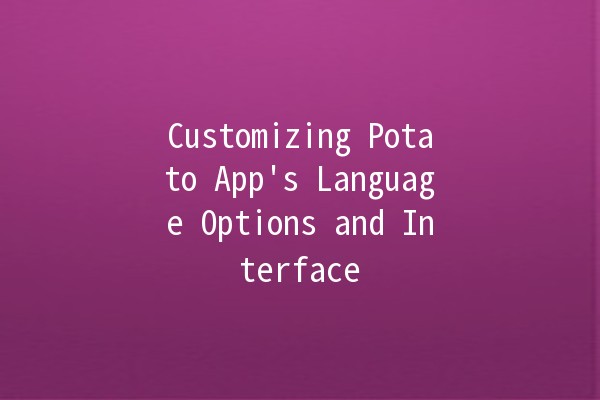In today's digital world, personalization is key, especially when it comes to apps. The Potato app is no exception; it allows users to customize their experience, including language settings and interface design. Setting up these preferences is essential for optimizing user experience and productivity. This article delves into efficient ways to customize the Potato app to suit individual needs while enhancing usability and performance. Let’s explore various techniques and tips for effectively managing language options and interface settings.
Understanding the Importance of Language Options
Language options in apps play a crucial role in user accessibility and engagement. Users are more likely to interact with an app that speaks their language, both literally and metaphorically. By providing language options:
Setting Language Options in Potato App

To begin customizing language settings, users must locate the language options within the app. Typically, these settings can be found under the "Settings" or "Preferences" menu.
Practical Step:
Open the Potato app and click on the gear icon (⚙️) located in the top right corner.
Select "Language Settings" from the dropdown list.
Once inside the language settings, users can select their preferred language. Potato likely supports multiple languages to cater to its diverse user base.
Productivity Tip:
When selecting a language, consider any regional dialects or variations that may impact understanding. For instance, choosing between American English and British English may affect spelling and certain terminologies.
After changing the language settings, it’s a good idea to test the app’s features in the new language. This ensures that all elements, including buttons, instructions, and customer support, are appropriately translated.
Practical Step:
Engage with the app for a few tasks to ensure the language setting feels natural and intuitive. Adjust any preferences as necessary.
Customizing the Interface
A wellcustomized interface can significantly enhance user experience, making the app not only functional but also visually appealing.
The Potato app may provide options for adjusting its theme and color schemes. A visually pleasing interface can improve usability and reduce strain during extended usage.
Productivity Tip:
Opt for a “dark mode” if available. Dark backgrounds can reduce eye strain, especially in lowlight environments.
Customizing the home screen layout can streamline accessibility and improve your workflow. Many apps, including Potato, allow users to pin frequently used features or widgets to the home screen.
Practical Step:
Identify which features you access most often, such as task manager or notes, and pin them for quicker access.
Advanced Customization Techniques
Shortcuts can be a gamechanger for productivity within the Potato app. By utilizing keyboard shortcuts or customizable gestures, you can perform frequent actions quickly, saving time and effort.
Practical Step:
Explore the settings to see if the app supports keyboard shortcuts or gestures. Create a list of those you find most useful.
For users who switch between projects or tasks frequently, setting up multiple profiles within the app can enhance organization and productivity. Each profile can have its language and interface settings.
Productivity Tip:
Use distinct profiles for personal vs. workrelated tasks, making switching between different environments seamless.
Consider integrating thirdparty tools or plugins that can enhance the functionality of the Potato app. These integrations might provide additional customization options for language and interface.
Practical Step:
Research and identify compatible tools that can enhance your experience without overwhelming the interface.
Putting It All Together
To maximize the Potato app's capabilities, users must continuously tailor their settings to align with their personal preferences and workflow styles. By focusing on language and interface customization, users can create a unique experience that not only meets their needs but also boosts productivity.
Frequently Asked Questions
Q1: How do I reset my language options?
To reset language options, navigate to "Settings," select "Language," and scroll to the bottom to find a reset option or choose your original language from the dropdown menu.
Q2: Can I suggest new languages for the app?
Yes, most apps welcome user feedback. Look for a feedback option within the app or contact customer support to suggest new languages.
Q3: What if my preferred language isn't available?
If your preferred language isn’t an option, consider reaching out to customer support. They may provide information on upcoming language updates.
Q4: How can I switch back to my previous interface settings?
Access "Settings," navigate to "Interface," and select your previous settings from the saved configurations list.
Q5: Are there accessibility options for users with disabilities?
Yes, check the accessibility settings in the app, where you can enable features like texttospeech, high contrast mode, or adjust text sizes for better accessibility.
Q6: Will changing languages affect my saved data?
No, changing languages should not affect your saved data. However, it’s always good to back up important data before making any changes.
By implementing these insights and options, users of the Potato app can significantly enhance their navigation, engagement, and overall productivity. The customization capabilities of the app allow every individual to tailor their experience according to their preferences, ultimately leading to a more satisfying and efficient usage. Happy customizations!